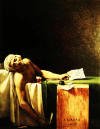Search:: Artists Alphabetically Symbolism 50 Greatest Paintings Art Movements 100 Greatest Painters
The word Neoclassical comes from the translates to 'New Classical'
Neoclassical Art
"The Art of The French Revolution"
1750-1850
Description and Origins of the Neoclassic Art MovementThe heart of Neo-Classical movement was centered in Rome, where expatriate artists congregated around the flamboyant German classical archaeologist and art critic Johann Joachim Wincklemann.
Winckelmann gushed about the "noble simplicity and quiet grandeur” of Greek sculpture, which he believed to be the most perfect beauty ever created by human hands, and recommended that artists emulate these classical forms. The period is called neoclassical because its artists looked back to the art and culture of classical Greece and Rome. The word Neoclassical comes from the translates to 'New Classical'.Wincklemann wrote about roman archeological excavations and touted the homoeroticism of Greco-Roman art, writing explicit descriptions erotic male sculptures from Classical Antiquity thereby encouraging an interest in Greek antiquities. According to Winckelmanns biographer, Walter Pater, "his affinity with Hellenism was not merely intellectual, that the subtler threads of temperament were interwoven in it, is proved by his romantic, fervent friendships with young men. He has known, he says, many young men more beautiful than Guido’s archangel. These friendships, bringing him into contact with the pride of human form, and staining the thoughts with its bloom, perfected his reconciliation to the spirit of Greek sculpture. "
Neoclassical art is characterized by its classical form and structure,
clarity, and to an degree, realism. More than just a classical revival,
Neo-Classicism was directly connected to contemporary political events.
Neo-Classical artists at first wanted to supplant the eroticism and
frivolity of the Rococo style with a style that was orderly and serious
in character. French Neoclassism painters emphasis's patriotism, as
well as a sense of civility and honorableness. The movement was
particularly connected with the beliefs of the French Revolution and was
seen as anti-aristocratic. The fantasy-based aristocratic art of the
French painter
Jacques-Louis David was infatuated with the former grandeur of Rome and even painted the tiny, pudgy Napoleon as a magnificent warrior astride a white stallion. David declared "I will never, for the future, paint the portrait of a tyrant until his head lies before me on the scaffold."Mythology, Revolutionary themes, folklore, legends, and the calm grandeur of a bygone era were all favored themes for Neoclassical painters.
Important Neoclassical Artists
Antonio Canova (1757-1822) Italian, Neoclassical
Jacques-Louis David (1748 - 1824) French, Neoclassical
Francois Gerard (1770-1837) Italian, Neoclassical
Antoine-Jean Gros 1771-1835) French, Neoclassical
Jean-Auguste-Dominique Ingres (1780 - 1867) French, Neoclassical
Angelica Kauffman (1741 - 1807) Swiss, Neoclassical
Rembrandt Peale (1778-1860) American, Neoclassical
Bertel Thorvaldsen (1770-1844) Dutch, Neoclassical
John Trumbull (1756-1843) American, Neoclassical
Élizabeth Louise Vigée-Lebrun (1755 - 1842) French, Neoclassical
Benjamin West (1738 - 1820) American, Neoclassical
☼☼☼☼☼
☼☼☼☼☼
Require more facts and information about Neoclassicism? Poke around every nook and cranny of the known universe for information this subject. Search Here
☼☼☼☼☼☼☼☼☼☼
If you feel you have worthwhile information you would like to contribute we would love to hear from you. We collect essential biographical information and artist quotes from folks all over the globe and appreciate your participation. When submitting please, if possible, site the source and provide English translation. Please submit your comment to the editor, via e-mail and if possible site the source. Thank you!
copyright 1999 - 2011 historyofpainters.com
© HistoryofPainters.com If you like this page and wish to share
it, you are welcome to link to it, with our thanks.
